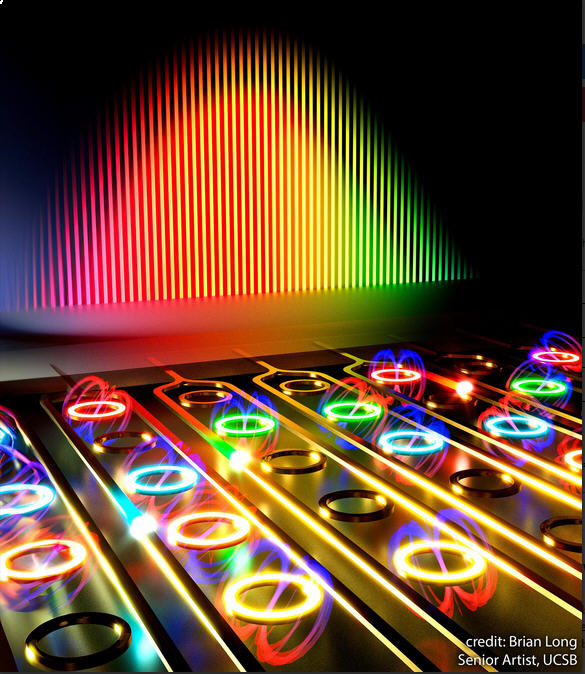光速突破:光子内存计算的曙光
诸平
据美国匹兹堡大学(University of Pittsburgh)2024年10月26日提供的消息,光速突破:光子内存计算的曙光(Light-Speed Breakthrough: The Dawn of Photonic In-Memory Computing)。
研究人员公布了一种新的光子内存计算方法(photonic in-memory computing method),有望显著推进光学计算。该技术使用磁光材料(magneto-optical materials),实现了适合与现有计算技术集成的高速、低能耗和耐用的存储解决方案。
光子内存计算(Photonic In-Memory Computing)
一个由全球电气工程师组成的团队首次开发了一种新的光子内存计算方法,使光学计算更接近成为现实。
该团队包括来自美国匹兹堡大学斯旺森工程学院(University of Pittsburgh Swanson School of Engineering, Pittsburgh, PA, USA)、美国加州大学圣巴巴拉分校(University of California, Santa Barbara, CA, USA)、意大利卡利亚里大学(University of Cagliari, Cagliari, Italy)、日本国家先进工业科学技术研究所{National Institute of Advanced Industrial Science and Technology (AIST), Ibaraki, Japan}以及日本东京工业大学(Tokyo Institute of Technology, Tokyo, Japan)的研究人员。他们的研究结果2024年10月23日已经在《自然光子学》(Nature Photonics)杂志网站在线发表——Paolo Pintus, Mario Dumont, Vivswan Shah, Toshiya Murai, Yuya Shoji, Duanni Huang, Galan Moody, John E. Bowers, Nathan Youngblood. Integrated non-reciprocal magneto-optics with ultra-high endurance for photonic in-memory computing. Nature Photonics, 2024, . DOI: 10.1038/s41566-024-01549-1. Published: 23 October 2024. https://www.nature.com/articles/s41566-024-01549-1
这项研究是由匹兹堡大学电子和计算机工程助理教授内森·扬布拉德(Nathan Youngblood)、加州大学圣巴巴拉分校前助理教授保罗·平图斯(Paulo Pintus)和东京科学大学{Tokyo Institute of Technology (now the Institute of Science Tokyo)}副教授庄司雄哉(Yuya Shoji)共同领导的。
克服光存储限制(Overcoming Optical Memory Limitations)
到目前为止,研究人员在开发用于人工智能处理的光子存储器方面受到限制,获得了一个重要的属性,如速度,同时牺牲了另一个重要属性,如能量使用。在这篇文章中,国际团队展示了一种独特的解决方案,解决了当前光存储器的局限性,这些局限性尚未在单一平台中结合非易失性(non-volatility)、多比特存储(multibit storage)、高交换速度(high switching speed)、低开关能量(low switching energy)和高耐用性(high endurance)。
内森·扬布拉德解释说:“我们用于开发这些单元格的材料已经有几十年了。然而,它们主要用于静态光学应用,如芯片上隔离器(on-chip isolators),而不是高性能光子存储平台。这一发现是实现更快、更高效、更可扩展的光学计算架构的关键技术,该架构可以直接与互补金属氧化物半导体(complementary metal-oxide semiconductor简称CMOS)电路编程,这意味着它可以集成到今天的计算机技术中。此外,我们的技术显示出比其他非易失性方法更好的三个数量级的耐久性,具有24亿切换周期和纳秒速度。”
引入基于共振的体系结构(Introducing a Resonance-Based Architecture)
作者提出了一种基于共振的光子结构,利用磁光材料(magneto-optical materials)中的非互易相移(non-reciprocal phase shift)来实现光子内存计算。
光子处理的一种典型方法是将快速变化的光输入矢量与固定光权的矩阵相乘。然而,使用传统方法和材料在芯片上编码这些权重是具有挑战性的。通过在硅微环谐振器上使用由异质集成惨铈钇铁石榴石(cerium-substituted yttrium iron garnet简称Ce:YIG)组成的磁光存储单元,这些单元可以使光双向传播,就像短跑运动员在跑道上朝相反方向跑一样。
通过控制光速进行计算(Computing by Controlling the Speed of Light)
在美国加州大学圣巴巴拉分校领导实验工作的保罗·平图斯解释说:“这就像风在帮助一个短跑运动员跑得更快的同时,也在帮助另一个短跑运动员。通过对存储单元施加磁场,我们可以根据光在环形谐振器周围是顺时针还是逆时针流动来不同地控制光的速度。在更传统的非磁性材料中不可能提供这样一个额外的控制水平。”
未来展望及规模(Future Prospects and Scaling)
该团队目前正致力于将单个存储单元扩展到可以支持更多计算应用数据的大规模存储阵列。他们在文章中指出,非互易磁光存储单元提供了一种高效的非易失性存储解决方案,可以在亚纳秒的编程速度下提供无限的读/写持久性。
“我们还相信,这项技术的未来发展可以使用不同的效果来提高开关效率,”东京科学大学的庄司雄哉补充说,“使用Ce:YIG以外的材料和更精确的沉积的新制造技术可以进一步推进非互易光学计算(non-reciprocal optical computing)的潜力。”
本研究得到了美国国家科学基金会{ US National Science Foundation under (grant nos. ECCS-2210168/2210169, CISE-2105972 and OAC-2117681)}、匹兹堡大学计算研究中心{University of Pittsburgh Center for Research Computing (grant no. RRID:SCR_022735)}、美国空军科学研究办公室(Air Force Office of Scientific Research under award nos. FA9550-21-1-0042 and FA9550-20-1-0150)、意大利撒丁岛自治区(Autonomous Region of Sardinia via the ‘Mobilità Giovani Ricercatori (MGR)’ programme of the University of Cagliari)、意大利大学和研究部{Italian Ministry of University and Research via the PRIN PNRR 2022 project ‘Magneto-optic Integrated Computing (MAGIC)’ (grant no. CUP F53D23008340001)}、意大利撒丁岛基金会{Fondazione di Sardegna via the ‘Investigation of Novel Magneto-Optic Materials and Devices for Silicon Photonic Integrated Circuits’ project (grant no. CUP F73C23001820007)}的资助或支持。
上述介绍,仅供参考。欲了解更多信息,敬请注意浏览原文或者相关报道。
Processing information in the optical domain promises advantages in both speed and energy efficiency over existing digital hardware for a variety of emerging applications in artificial intelligence and machine learning. A typical approach to photonic processing is to multiply a rapidly changing optical input vector with a matrix of fixed optical weights. However, encoding these weights on-chip using an array of photonic memory cells is currently limited by a wide range of material- and device-level issues, such as the programming speed, extinction ratio and endurance, among others. Here we propose a new approach to encoding optical weights for in-memory photonic computing using magneto-optic memory cells comprising heterogeneously integrated cerium-substituted yttrium iron garnet (Ce:YIG) on silicon micro-ring resonators. We show that leveraging the non-reciprocal phase shift in such magneto-optic materials offers several key advantages over existing architectures, providing a fast (1 ns), efficient (143 fJ per bit) and robust (2.4 billion programming cycles) platform for on-chip optical processing.
转载本文请联系原作者获取授权,同时请注明本文来自诸平科学网博客。
链接地址:https://wap.sciencenet.cn/blog-212210-1457218.html?mobile=1
收藏


